MNG00703 Organisational Change: Reflective Essay on Transition
VerifiedAdded on 2023/06/07
|8
|2144
|336
Essay
AI Summary
This essay reflects on a personal experience of organisational change within Woolworths, an Australian retail company, focusing on a situation involving accusations of unfair labor practices. The author discusses the impact of this event on employee morale, company reputation, and customer loyalty. The essay explores various organisational change theories, including Lewin's Force-Field Theory, McKinsey 7-S model, Kotter's theory, and the ADKAR model, to analyse how the company could have better managed the situation. It highlights the importance of leadership, communication, and employee involvement in successful change management. The author concludes with personal insights gained from the experience, emphasising the need for proactive planning and continuous monitoring to sustain organisational changes and prevent future crises. Desklib provides access to similar essays and study resources for students.
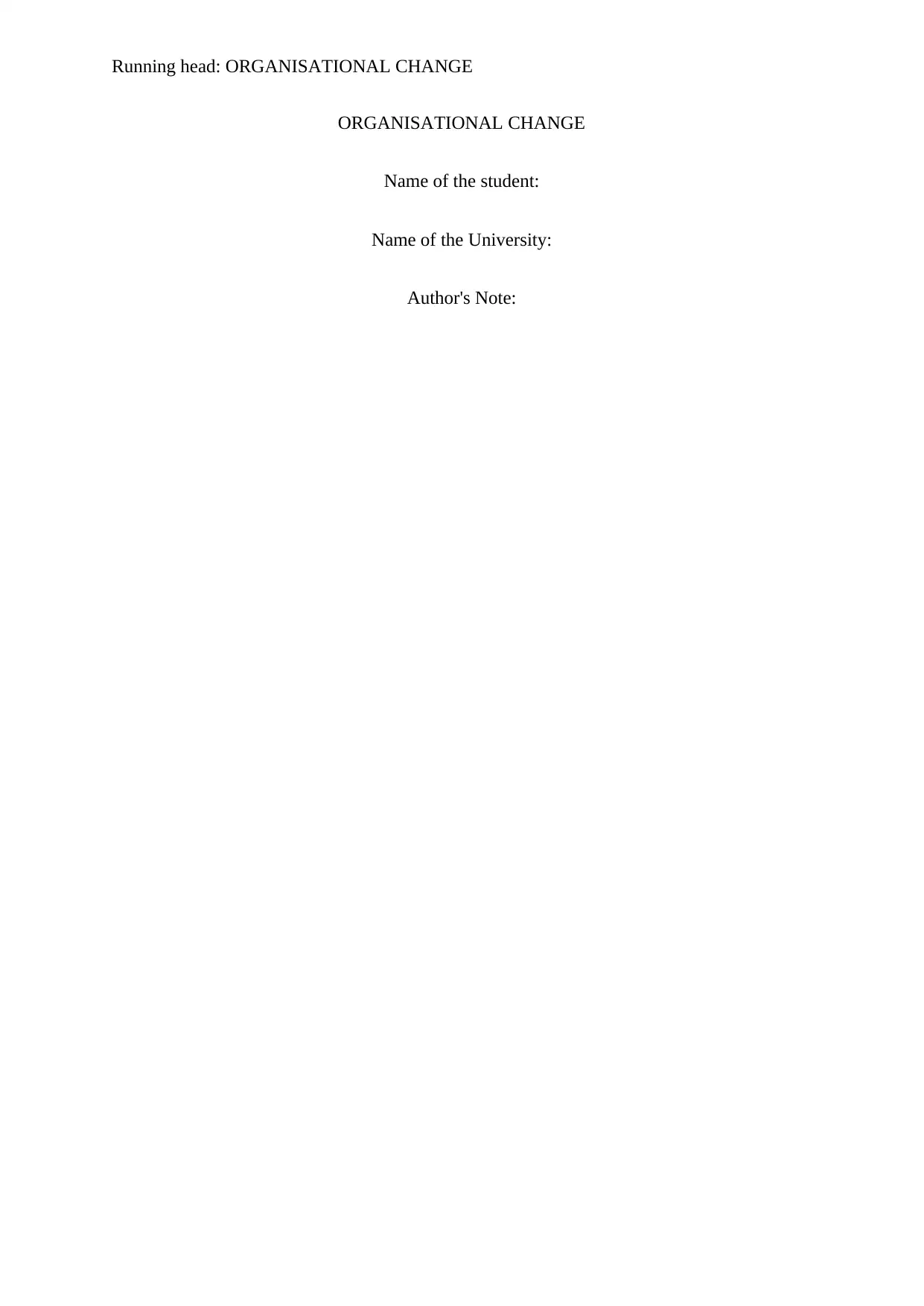
Running head: ORGANISATIONAL CHANGE
ORGANISATIONAL CHANGE
Name of the student:
Name of the University:
Author's Note:
ORGANISATIONAL CHANGE
Name of the student:
Name of the University:
Author's Note:
Paraphrase This Document
Need a fresh take? Get an instant paraphrase of this document with our AI Paraphraser
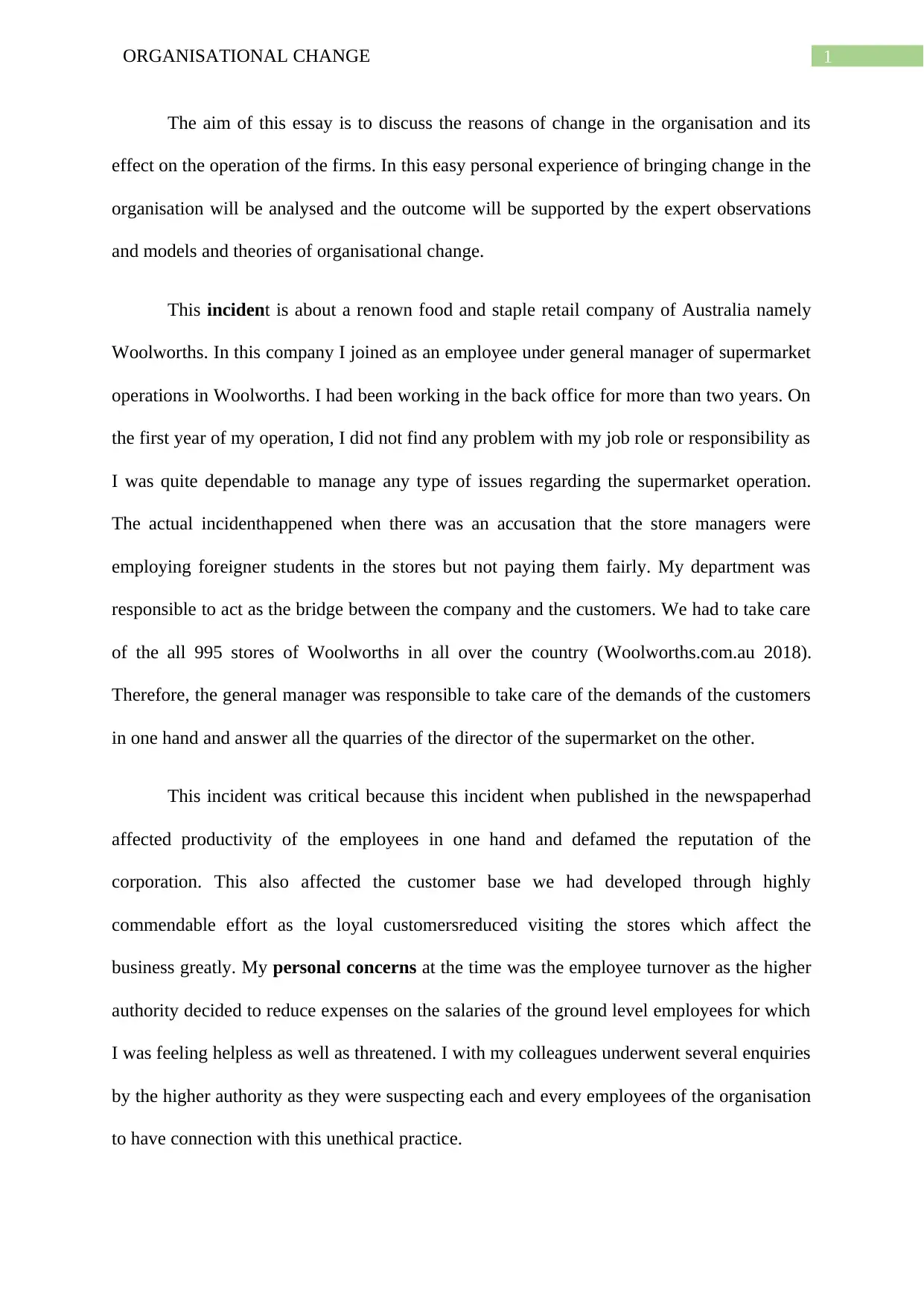
1ORGANISATIONAL CHANGE
The aim of this essay is to discuss the reasons of change in the organisation and its
effect on the operation of the firms. In this easy personal experience of bringing change in the
organisation will be analysed and the outcome will be supported by the expert observations
and models and theories of organisational change.
This incident is about a renown food and staple retail company of Australia namely
Woolworths. In this company I joined as an employee under general manager of supermarket
operations in Woolworths. I had been working in the back office for more than two years. On
the first year of my operation, I did not find any problem with my job role or responsibility as
I was quite dependable to manage any type of issues regarding the supermarket operation.
The actual incidenthappened when there was an accusation that the store managers were
employing foreigner students in the stores but not paying them fairly. My department was
responsible to act as the bridge between the company and the customers. We had to take care
of the all 995 stores of Woolworths in all over the country (Woolworths.com.au 2018).
Therefore, the general manager was responsible to take care of the demands of the customers
in one hand and answer all the quarries of the director of the supermarket on the other.
This incident was critical because this incident when published in the newspaperhad
affected productivity of the employees in one hand and defamed the reputation of the
corporation. This also affected the customer base we had developed through highly
commendable effort as the loyal customersreduced visiting the stores which affect the
business greatly. My personal concerns at the time was the employee turnover as the higher
authority decided to reduce expenses on the salaries of the ground level employees for which
I was feeling helpless as well as threatened. I with my colleagues underwent several enquiries
by the higher authority as they were suspecting each and every employees of the organisation
to have connection with this unethical practice.
The aim of this essay is to discuss the reasons of change in the organisation and its
effect on the operation of the firms. In this easy personal experience of bringing change in the
organisation will be analysed and the outcome will be supported by the expert observations
and models and theories of organisational change.
This incident is about a renown food and staple retail company of Australia namely
Woolworths. In this company I joined as an employee under general manager of supermarket
operations in Woolworths. I had been working in the back office for more than two years. On
the first year of my operation, I did not find any problem with my job role or responsibility as
I was quite dependable to manage any type of issues regarding the supermarket operation.
The actual incidenthappened when there was an accusation that the store managers were
employing foreigner students in the stores but not paying them fairly. My department was
responsible to act as the bridge between the company and the customers. We had to take care
of the all 995 stores of Woolworths in all over the country (Woolworths.com.au 2018).
Therefore, the general manager was responsible to take care of the demands of the customers
in one hand and answer all the quarries of the director of the supermarket on the other.
This incident was critical because this incident when published in the newspaperhad
affected productivity of the employees in one hand and defamed the reputation of the
corporation. This also affected the customer base we had developed through highly
commendable effort as the loyal customersreduced visiting the stores which affect the
business greatly. My personal concerns at the time was the employee turnover as the higher
authority decided to reduce expenses on the salaries of the ground level employees for which
I was feeling helpless as well as threatened. I with my colleagues underwent several enquiries
by the higher authority as they were suspecting each and every employees of the organisation
to have connection with this unethical practice.
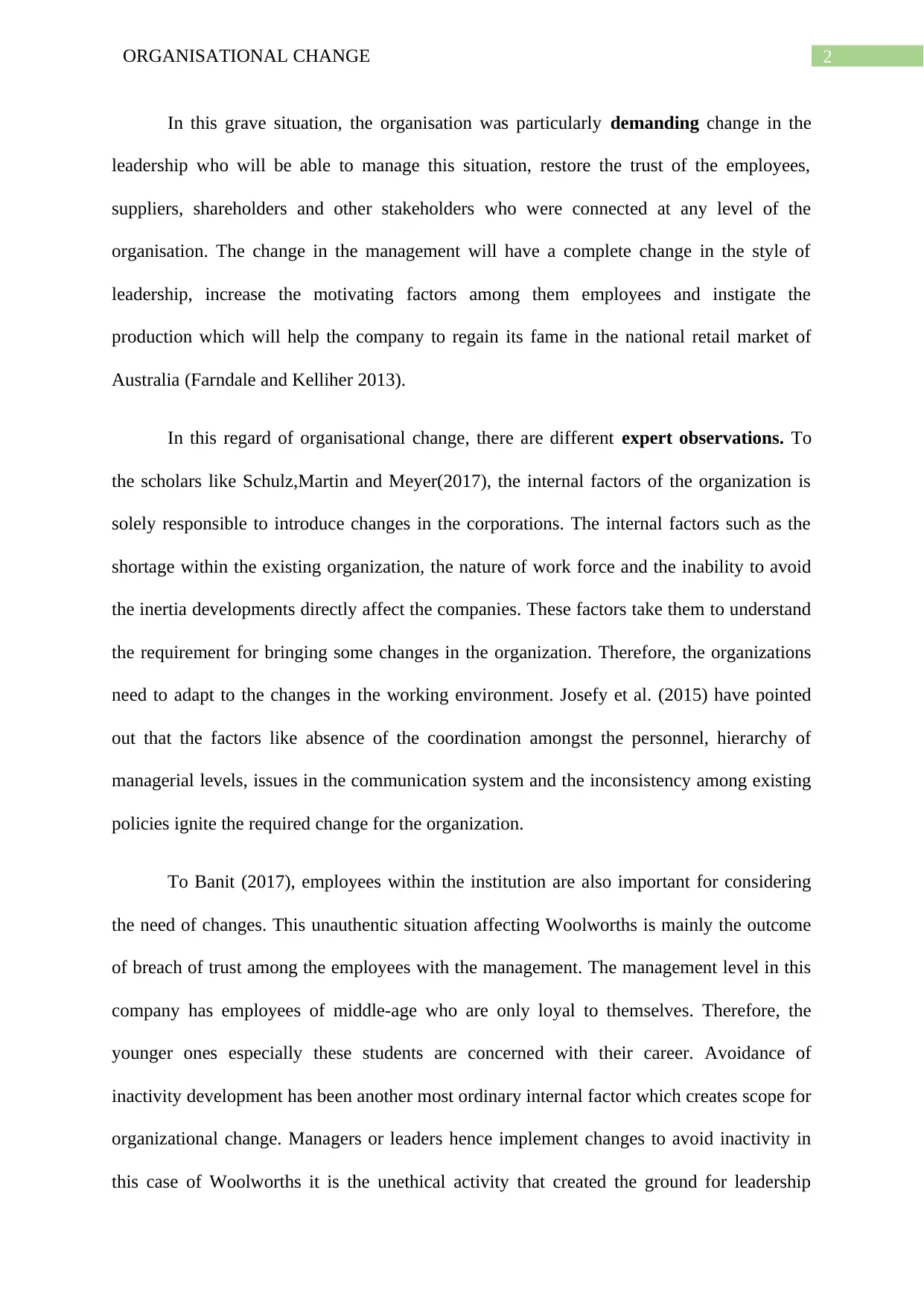
2ORGANISATIONAL CHANGE
In this grave situation, the organisation was particularly demanding change in the
leadership who will be able to manage this situation, restore the trust of the employees,
suppliers, shareholders and other stakeholders who were connected at any level of the
organisation. The change in the management will have a complete change in the style of
leadership, increase the motivating factors among them employees and instigate the
production which will help the company to regain its fame in the national retail market of
Australia (Farndale and Kelliher 2013).
In this regard of organisational change, there are different expert observations. To
the scholars like Schulz,Martin and Meyer(2017), the internal factors of the organization is
solely responsible to introduce changes in the corporations. The internal factors such as the
shortage within the existing organization, the nature of work force and the inability to avoid
the inertia developments directly affect the companies. These factors take them to understand
the requirement for bringing some changes in the organization. Therefore, the organizations
need to adapt to the changes in the working environment. Josefy et al. (2015) have pointed
out that the factors like absence of the coordination amongst the personnel, hierarchy of
managerial levels, issues in the communication system and the inconsistency among existing
policies ignite the required change for the organization.
To Banit (2017), employees within the institution are also important for considering
the need of changes. This unauthentic situation affecting Woolworths is mainly the outcome
of breach of trust among the employees with the management. The management level in this
company has employees of middle-age who are only loyal to themselves. Therefore, the
younger ones especially these students are concerned with their career. Avoidance of
inactivity development has been another most ordinary internal factor which creates scope for
organizational change. Managers or leaders hence implement changes to avoid inactivity in
this case of Woolworths it is the unethical activity that created the ground for leadership
In this grave situation, the organisation was particularly demanding change in the
leadership who will be able to manage this situation, restore the trust of the employees,
suppliers, shareholders and other stakeholders who were connected at any level of the
organisation. The change in the management will have a complete change in the style of
leadership, increase the motivating factors among them employees and instigate the
production which will help the company to regain its fame in the national retail market of
Australia (Farndale and Kelliher 2013).
In this regard of organisational change, there are different expert observations. To
the scholars like Schulz,Martin and Meyer(2017), the internal factors of the organization is
solely responsible to introduce changes in the corporations. The internal factors such as the
shortage within the existing organization, the nature of work force and the inability to avoid
the inertia developments directly affect the companies. These factors take them to understand
the requirement for bringing some changes in the organization. Therefore, the organizations
need to adapt to the changes in the working environment. Josefy et al. (2015) have pointed
out that the factors like absence of the coordination amongst the personnel, hierarchy of
managerial levels, issues in the communication system and the inconsistency among existing
policies ignite the required change for the organization.
To Banit (2017), employees within the institution are also important for considering
the need of changes. This unauthentic situation affecting Woolworths is mainly the outcome
of breach of trust among the employees with the management. The management level in this
company has employees of middle-age who are only loyal to themselves. Therefore, the
younger ones especially these students are concerned with their career. Avoidance of
inactivity development has been another most ordinary internal factor which creates scope for
organizational change. Managers or leaders hence implement changes to avoid inactivity in
this case of Woolworths it is the unethical activity that created the ground for leadership
⊘ This is a preview!⊘
Do you want full access?
Subscribe today to unlock all pages.

Trusted by 1+ million students worldwide
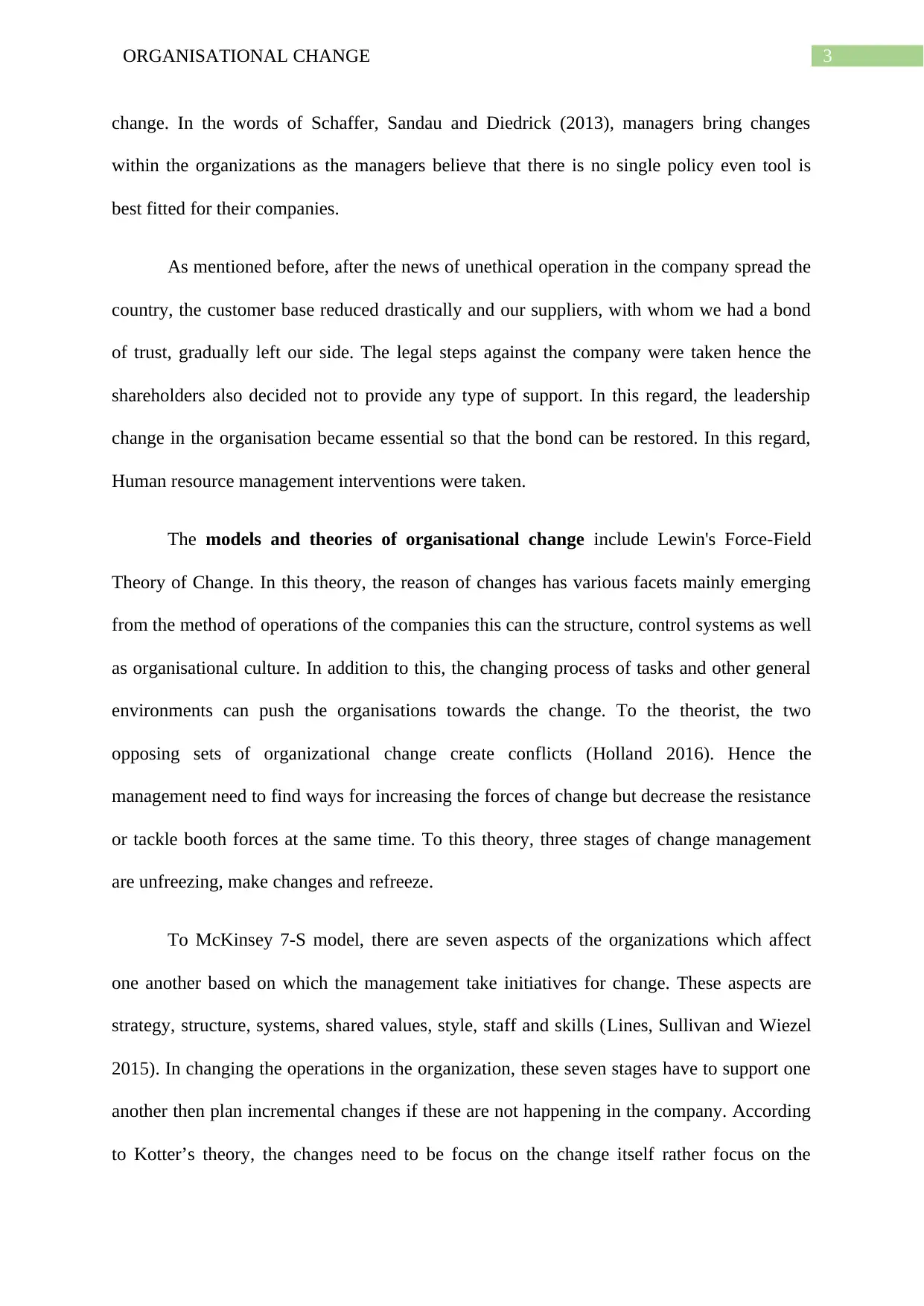
3ORGANISATIONAL CHANGE
change. In the words of Schaffer, Sandau and Diedrick (2013), managers bring changes
within the organizations as the managers believe that there is no single policy even tool is
best fitted for their companies.
As mentioned before, after the news of unethical operation in the company spread the
country, the customer base reduced drastically and our suppliers, with whom we had a bond
of trust, gradually left our side. The legal steps against the company were taken hence the
shareholders also decided not to provide any type of support. In this regard, the leadership
change in the organisation became essential so that the bond can be restored. In this regard,
Human resource management interventions were taken.
The models and theories of organisational change include Lewin's Force-Field
Theory of Change. In this theory, the reason of changes has various facets mainly emerging
from the method of operations of the companies this can the structure, control systems as well
as organisational culture. In addition to this, the changing process of tasks and other general
environments can push the organisations towards the change. To the theorist, the two
opposing sets of organizational change create conflicts (Holland 2016). Hence the
management need to find ways for increasing the forces of change but decrease the resistance
or tackle booth forces at the same time. To this theory, three stages of change management
are unfreezing, make changes and refreeze.
To McKinsey 7-S model, there are seven aspects of the organizations which affect
one another based on which the management take initiatives for change. These aspects are
strategy, structure, systems, shared values, style, staff and skills (Lines, Sullivan and Wiezel
2015). In changing the operations in the organization, these seven stages have to support one
another then plan incremental changes if these are not happening in the company. According
to Kotter’s theory, the changes need to be focus on the change itself rather focus on the
change. In the words of Schaffer, Sandau and Diedrick (2013), managers bring changes
within the organizations as the managers believe that there is no single policy even tool is
best fitted for their companies.
As mentioned before, after the news of unethical operation in the company spread the
country, the customer base reduced drastically and our suppliers, with whom we had a bond
of trust, gradually left our side. The legal steps against the company were taken hence the
shareholders also decided not to provide any type of support. In this regard, the leadership
change in the organisation became essential so that the bond can be restored. In this regard,
Human resource management interventions were taken.
The models and theories of organisational change include Lewin's Force-Field
Theory of Change. In this theory, the reason of changes has various facets mainly emerging
from the method of operations of the companies this can the structure, control systems as well
as organisational culture. In addition to this, the changing process of tasks and other general
environments can push the organisations towards the change. To the theorist, the two
opposing sets of organizational change create conflicts (Holland 2016). Hence the
management need to find ways for increasing the forces of change but decrease the resistance
or tackle booth forces at the same time. To this theory, three stages of change management
are unfreezing, make changes and refreeze.
To McKinsey 7-S model, there are seven aspects of the organizations which affect
one another based on which the management take initiatives for change. These aspects are
strategy, structure, systems, shared values, style, staff and skills (Lines, Sullivan and Wiezel
2015). In changing the operations in the organization, these seven stages have to support one
another then plan incremental changes if these are not happening in the company. According
to Kotter’s theory, the changes need to be focus on the change itself rather focus on the
Paraphrase This Document
Need a fresh take? Get an instant paraphrase of this document with our AI Paraphraser
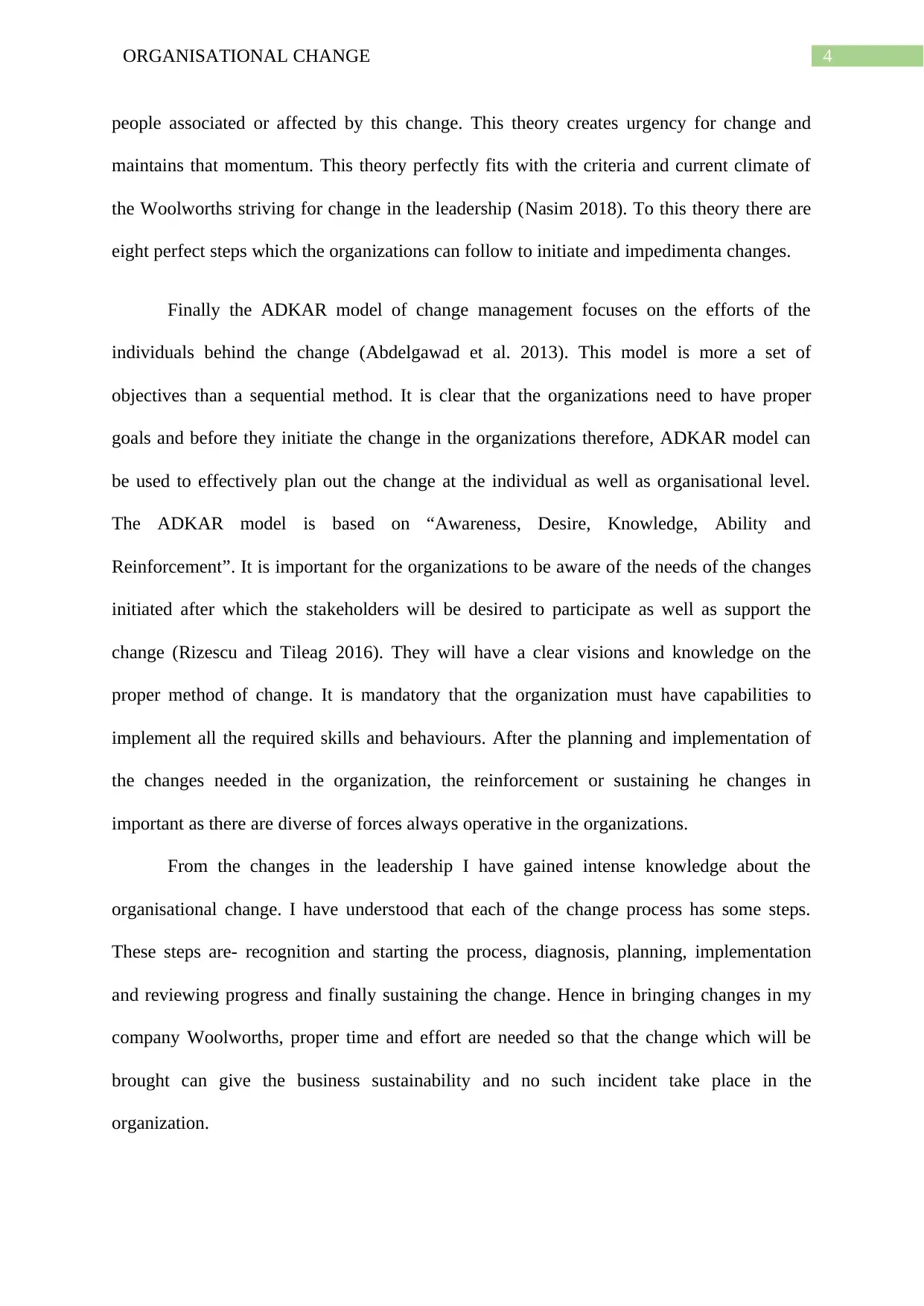
4ORGANISATIONAL CHANGE
people associated or affected by this change. This theory creates urgency for change and
maintains that momentum. This theory perfectly fits with the criteria and current climate of
the Woolworths striving for change in the leadership (Nasim 2018). To this theory there are
eight perfect steps which the organizations can follow to initiate and impedimenta changes.
Finally the ADKAR model of change management focuses on the efforts of the
individuals behind the change (Abdelgawad et al. 2013). This model is more a set of
objectives than a sequential method. It is clear that the organizations need to have proper
goals and before they initiate the change in the organizations therefore, ADKAR model can
be used to effectively plan out the change at the individual as well as organisational level.
The ADKAR model is based on “Awareness, Desire, Knowledge, Ability and
Reinforcement”. It is important for the organizations to be aware of the needs of the changes
initiated after which the stakeholders will be desired to participate as well as support the
change (Rizescu and Tileag 2016). They will have a clear visions and knowledge on the
proper method of change. It is mandatory that the organization must have capabilities to
implement all the required skills and behaviours. After the planning and implementation of
the changes needed in the organization, the reinforcement or sustaining he changes in
important as there are diverse of forces always operative in the organizations.
From the changes in the leadership I have gained intense knowledge about the
organisational change. I have understood that each of the change process has some steps.
These steps are- recognition and starting the process, diagnosis, planning, implementation
and reviewing progress and finally sustaining the change. Hence in bringing changes in my
company Woolworths, proper time and effort are needed so that the change which will be
brought can give the business sustainability and no such incident take place in the
organization.
people associated or affected by this change. This theory creates urgency for change and
maintains that momentum. This theory perfectly fits with the criteria and current climate of
the Woolworths striving for change in the leadership (Nasim 2018). To this theory there are
eight perfect steps which the organizations can follow to initiate and impedimenta changes.
Finally the ADKAR model of change management focuses on the efforts of the
individuals behind the change (Abdelgawad et al. 2013). This model is more a set of
objectives than a sequential method. It is clear that the organizations need to have proper
goals and before they initiate the change in the organizations therefore, ADKAR model can
be used to effectively plan out the change at the individual as well as organisational level.
The ADKAR model is based on “Awareness, Desire, Knowledge, Ability and
Reinforcement”. It is important for the organizations to be aware of the needs of the changes
initiated after which the stakeholders will be desired to participate as well as support the
change (Rizescu and Tileag 2016). They will have a clear visions and knowledge on the
proper method of change. It is mandatory that the organization must have capabilities to
implement all the required skills and behaviours. After the planning and implementation of
the changes needed in the organization, the reinforcement or sustaining he changes in
important as there are diverse of forces always operative in the organizations.
From the changes in the leadership I have gained intense knowledge about the
organisational change. I have understood that each of the change process has some steps.
These steps are- recognition and starting the process, diagnosis, planning, implementation
and reviewing progress and finally sustaining the change. Hence in bringing changes in my
company Woolworths, proper time and effort are needed so that the change which will be
brought can give the business sustainability and no such incident take place in the
organization.
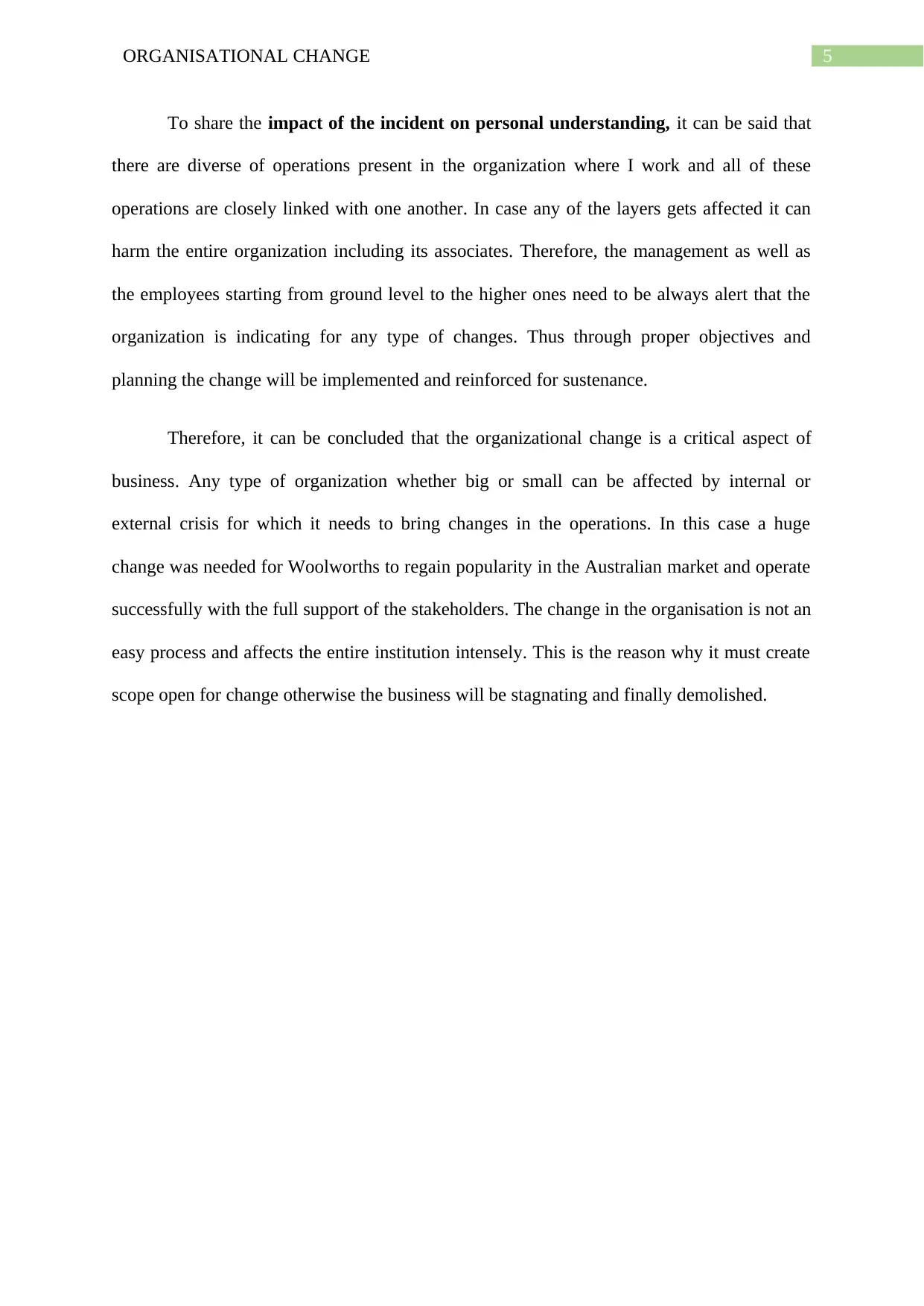
5ORGANISATIONAL CHANGE
To share the impact of the incident on personal understanding, it can be said that
there are diverse of operations present in the organization where I work and all of these
operations are closely linked with one another. In case any of the layers gets affected it can
harm the entire organization including its associates. Therefore, the management as well as
the employees starting from ground level to the higher ones need to be always alert that the
organization is indicating for any type of changes. Thus through proper objectives and
planning the change will be implemented and reinforced for sustenance.
Therefore, it can be concluded that the organizational change is a critical aspect of
business. Any type of organization whether big or small can be affected by internal or
external crisis for which it needs to bring changes in the operations. In this case a huge
change was needed for Woolworths to regain popularity in the Australian market and operate
successfully with the full support of the stakeholders. The change in the organisation is not an
easy process and affects the entire institution intensely. This is the reason why it must create
scope open for change otherwise the business will be stagnating and finally demolished.
To share the impact of the incident on personal understanding, it can be said that
there are diverse of operations present in the organization where I work and all of these
operations are closely linked with one another. In case any of the layers gets affected it can
harm the entire organization including its associates. Therefore, the management as well as
the employees starting from ground level to the higher ones need to be always alert that the
organization is indicating for any type of changes. Thus through proper objectives and
planning the change will be implemented and reinforced for sustenance.
Therefore, it can be concluded that the organizational change is a critical aspect of
business. Any type of organization whether big or small can be affected by internal or
external crisis for which it needs to bring changes in the operations. In this case a huge
change was needed for Woolworths to regain popularity in the Australian market and operate
successfully with the full support of the stakeholders. The change in the organisation is not an
easy process and affects the entire institution intensely. This is the reason why it must create
scope open for change otherwise the business will be stagnating and finally demolished.
⊘ This is a preview!⊘
Do you want full access?
Subscribe today to unlock all pages.

Trusted by 1+ million students worldwide
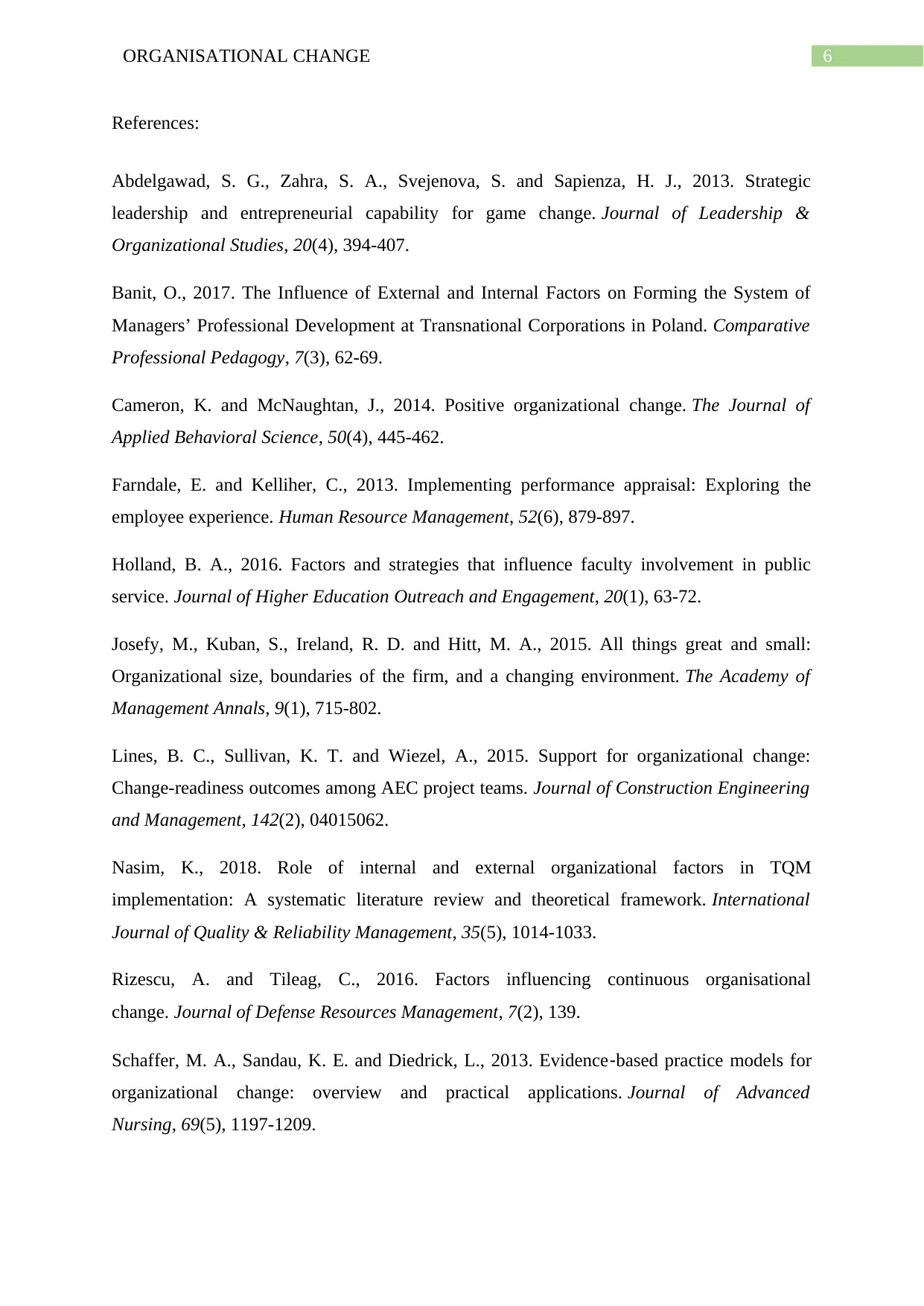
6ORGANISATIONAL CHANGE
References:
Abdelgawad, S. G., Zahra, S. A., Svejenova, S. and Sapienza, H. J., 2013. Strategic
leadership and entrepreneurial capability for game change. Journal of Leadership &
Organizational Studies, 20(4), 394-407.
Banit, O., 2017. The Influence of External and Internal Factors on Forming the System of
Managers’ Professional Development at Transnational Corporations in Poland. Comparative
Professional Pedagogy, 7(3), 62-69.
Cameron, K. and McNaughtan, J., 2014. Positive organizational change. The Journal of
Applied Behavioral Science, 50(4), 445-462.
Farndale, E. and Kelliher, C., 2013. Implementing performance appraisal: Exploring the
employee experience. Human Resource Management, 52(6), 879-897.
Holland, B. A., 2016. Factors and strategies that influence faculty involvement in public
service. Journal of Higher Education Outreach and Engagement, 20(1), 63-72.
Josefy, M., Kuban, S., Ireland, R. D. and Hitt, M. A., 2015. All things great and small:
Organizational size, boundaries of the firm, and a changing environment. The Academy of
Management Annals, 9(1), 715-802.
Lines, B. C., Sullivan, K. T. and Wiezel, A., 2015. Support for organizational change:
Change-readiness outcomes among AEC project teams. Journal of Construction Engineering
and Management, 142(2), 04015062.
Nasim, K., 2018. Role of internal and external organizational factors in TQM
implementation: A systematic literature review and theoretical framework. International
Journal of Quality & Reliability Management, 35(5), 1014-1033.
Rizescu, A. and Tileag, C., 2016. Factors influencing continuous organisational
change. Journal of Defense Resources Management, 7(2), 139.
Schaffer, M. A., Sandau, K. E. and Diedrick, L., 2013. Evidence‐based practice models for
organizational change: overview and practical applications. Journal of Advanced
Nursing, 69(5), 1197-1209.
References:
Abdelgawad, S. G., Zahra, S. A., Svejenova, S. and Sapienza, H. J., 2013. Strategic
leadership and entrepreneurial capability for game change. Journal of Leadership &
Organizational Studies, 20(4), 394-407.
Banit, O., 2017. The Influence of External and Internal Factors on Forming the System of
Managers’ Professional Development at Transnational Corporations in Poland. Comparative
Professional Pedagogy, 7(3), 62-69.
Cameron, K. and McNaughtan, J., 2014. Positive organizational change. The Journal of
Applied Behavioral Science, 50(4), 445-462.
Farndale, E. and Kelliher, C., 2013. Implementing performance appraisal: Exploring the
employee experience. Human Resource Management, 52(6), 879-897.
Holland, B. A., 2016. Factors and strategies that influence faculty involvement in public
service. Journal of Higher Education Outreach and Engagement, 20(1), 63-72.
Josefy, M., Kuban, S., Ireland, R. D. and Hitt, M. A., 2015. All things great and small:
Organizational size, boundaries of the firm, and a changing environment. The Academy of
Management Annals, 9(1), 715-802.
Lines, B. C., Sullivan, K. T. and Wiezel, A., 2015. Support for organizational change:
Change-readiness outcomes among AEC project teams. Journal of Construction Engineering
and Management, 142(2), 04015062.
Nasim, K., 2018. Role of internal and external organizational factors in TQM
implementation: A systematic literature review and theoretical framework. International
Journal of Quality & Reliability Management, 35(5), 1014-1033.
Rizescu, A. and Tileag, C., 2016. Factors influencing continuous organisational
change. Journal of Defense Resources Management, 7(2), 139.
Schaffer, M. A., Sandau, K. E. and Diedrick, L., 2013. Evidence‐based practice models for
organizational change: overview and practical applications. Journal of Advanced
Nursing, 69(5), 1197-1209.
Paraphrase This Document
Need a fresh take? Get an instant paraphrase of this document with our AI Paraphraser
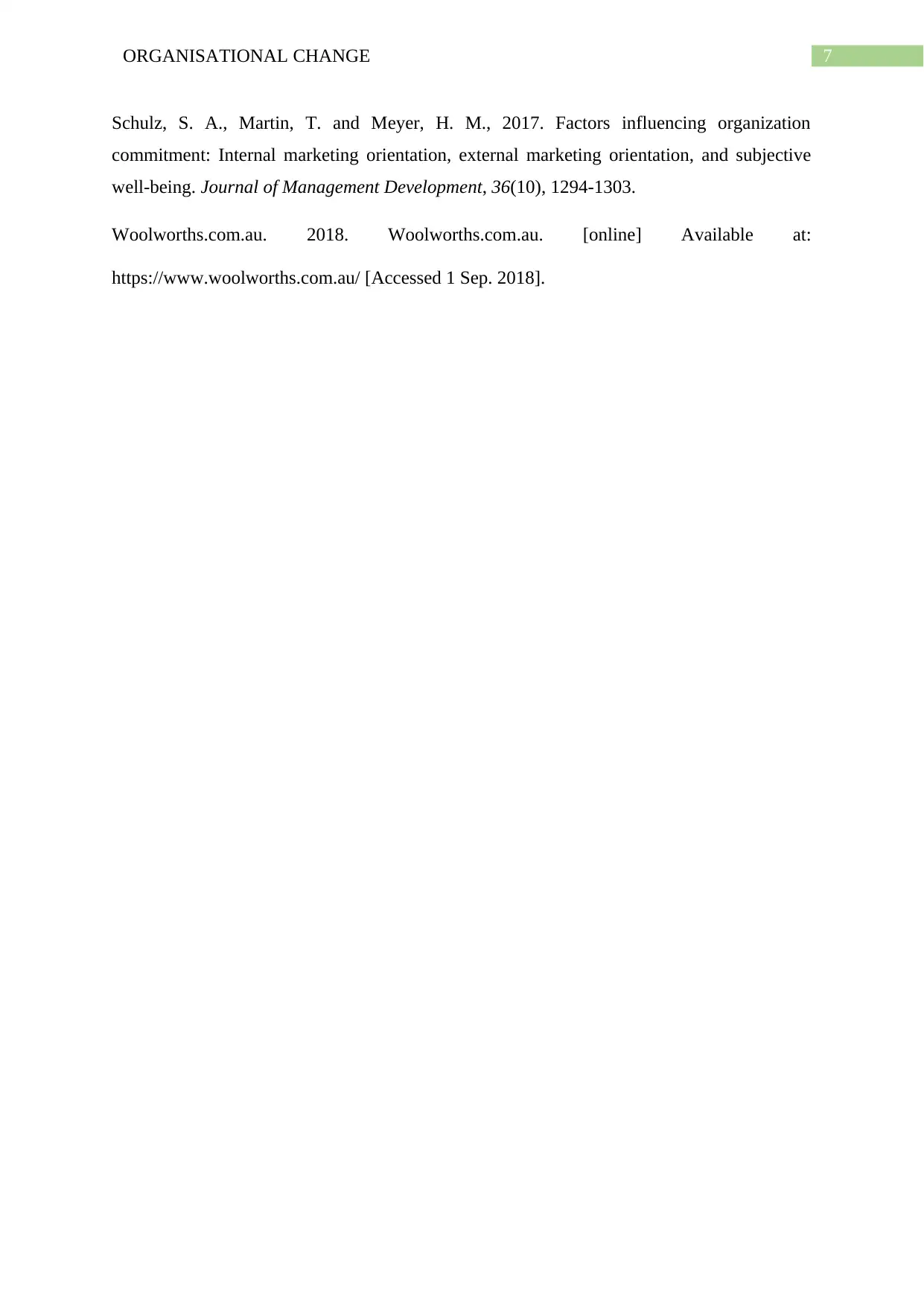
7ORGANISATIONAL CHANGE
Schulz, S. A., Martin, T. and Meyer, H. M., 2017. Factors influencing organization
commitment: Internal marketing orientation, external marketing orientation, and subjective
well-being. Journal of Management Development, 36(10), 1294-1303.
Woolworths.com.au. 2018. Woolworths.com.au. [online] Available at:
https://www.woolworths.com.au/ [Accessed 1 Sep. 2018].
Schulz, S. A., Martin, T. and Meyer, H. M., 2017. Factors influencing organization
commitment: Internal marketing orientation, external marketing orientation, and subjective
well-being. Journal of Management Development, 36(10), 1294-1303.
Woolworths.com.au. 2018. Woolworths.com.au. [online] Available at:
https://www.woolworths.com.au/ [Accessed 1 Sep. 2018].
1 out of 8
Related Documents
Your All-in-One AI-Powered Toolkit for Academic Success.
+13062052269
info@desklib.com
Available 24*7 on WhatsApp / Email
![[object Object]](/_next/static/media/star-bottom.7253800d.svg)
Unlock your academic potential
Copyright © 2020–2025 A2Z Services. All Rights Reserved. Developed and managed by ZUCOL.





